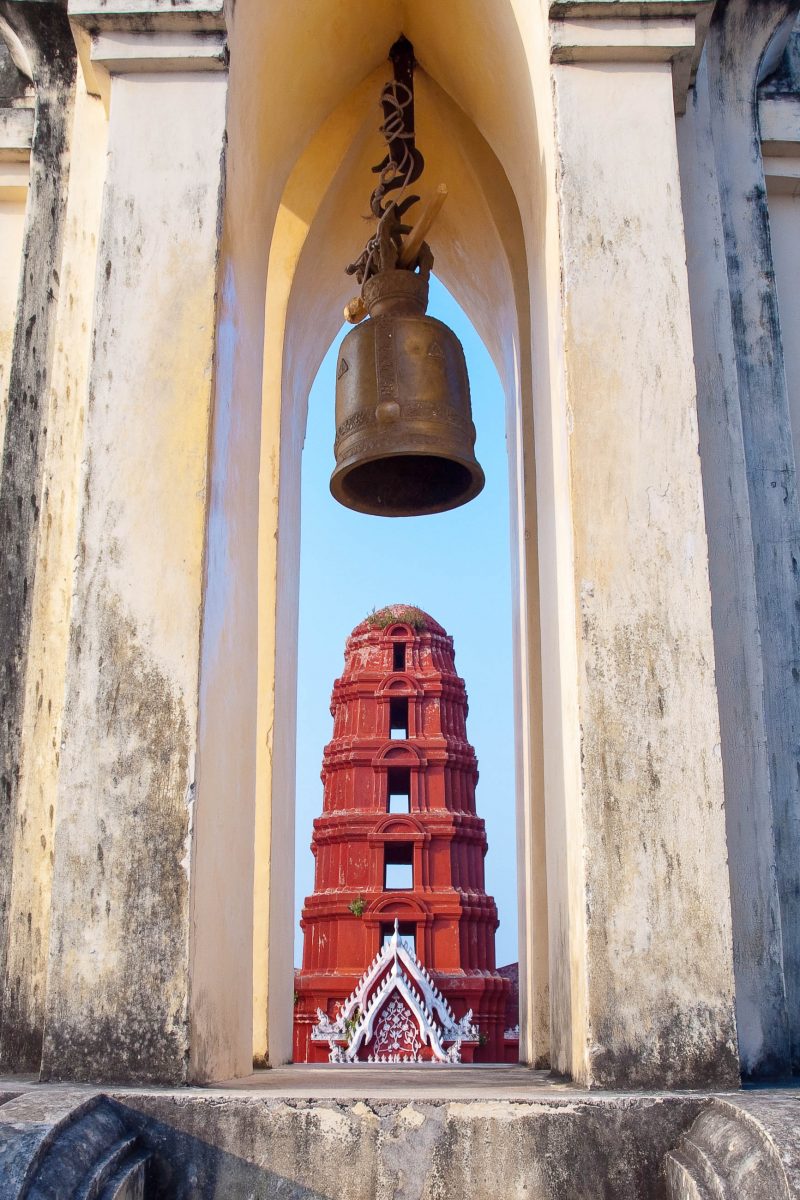Der Khao Wang auf einem Hügel über der historischen Stadt Petchaburi in Thailand diente einst schon König Rama IV. als Sommersitz und fungiert heute als Musuem und fantastischer Aussichtspunkt über Petchaburi.
Der Khao Wang Palast in der historischen Stadt Petchaburi im Süden Thailands ist eines der bekanntesten Wahrzeichen der Stadt und der erste Rattanakosin-Palast, der außerhalb von Bangkok errichtet wurde. Er thront auf einem Hügel über Petchaburi und bietet einen fantastischen Panorama-Blick über die Provinzhauptstadt.
Khao Wang bedeutet so viel wie „Palasthügel“. Ursprünglich hieß der Palast Phra Nakhon Khiri, doch die einfachere Bezeichnung hat sich bis heute in der Bevölkerung durchgesetzt. Das majestätische Gebäude macht seinem Namen alle Ehre. Von seinem knapp 100m hohen Hügel strahlt einem seine leuchtend weiße Fassade schon von weitem entgegen.
Der Khao Wang wurde im Jahr 1860 errichtet. Der thailändische König Rama IV war von der fantastischen Lage so angetan, dass er den dreihügeligen Khao Wang als Sommersitz für sich beanspruchte.
Tipp: Die beste Aussicht hat man vom Ho Chatchawan Wiang Chai. Der karmesinrote Turm am anderen Ende der Palastanlage gegenüber dem Chedi wurde von Rama IV. als Observatorium genutzt und dient heute den Fischern als Ausguck über die Ban Laem Bucht.
Der gesamte Palastkomplex auf seinem luftigen Sitz besteht aus mehreren königlichen Hallen und Palastgebäuden, sowie Tempelbauten, die einen interessanten Mix aus thailändischer, chinesischer und westlich geprägter Architektur aufweisen.

Auf dem mittleren Hügel thront der Blickfang des Palastes, ein 40 Meter hoher Chedi, die typisch spitz zulaufenden Türme der südostasiatischen Architektur. Innerhalb des Chedis befindet sich ein buddhistischer Schrein. Am östlichen Hügel befindet sich der Wat Phra Kaew, der der Kapelle des Smaragd-Buddha im Königspalast in Bangkok nachempfunden wurde.
Besuch des Khao Wang
Manche Teile des Khao Wang können auch von innen besichtigt werden, in einigen Räumlichkeiten ist heute ein Museum untergebracht. Im größten Hauptgebäude auf dem westlichen Hügel, dem Phra Thi Nang Phet Phum Phairot, der einst als Thronhalle fungierte, sind Möbel, Spiegel, Küchenutensilien und persönliche Gegenstände der Könige Rama IV. und Rama V. ausgestellt.
Im Phra Thi Nang Pramot Mahaisawan befanden sich die privaten Gemächer und Schlafräume der beiden Könige. Im Phra Thi Nang Wetchayan Wichian Prasat, welches im Khmer-Stil errichtet wurde, ist eine Statue von Rama IV. zu sehen.
Die beiden Gebäude werden heute unter der Bezeichnung „Phra Nakhon Khiri Nationalmuseum“ zusammengefasst, in denen neben den königlichen Habseligkeiten auch wertvolle Sammlungen von Antiquitäten, Bronzeskulpturen und Keramiken aus China, Japan und auch Europa ausgestellt sind.
Auch am Fuß des Hügels ist ein Museum zu besichtigen. Im Tempel „Maha Samanaram“ können Werke des renommierten thailändischen Künstlers Khrua In Khong bewundert werden, der in seinen Gemälden westlich geprägte Blickwinkel und Vogelperspektiven verwendet.





